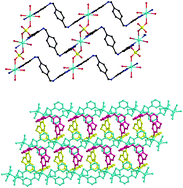Metal(ii) complexes based on 1,4-bis(3-pyridylaminomethyl)benzene: structures, photoluminescence and photocatalytic properties†
Abstract
Using a novel ditopic N-donor

* Corresponding authors
a
Department of Applied Chemistry, College of Chemistry and Chemical Engineering, Chongqing University, Chongqing 400030, P. R. China
E-mail:
jhlin@cqu.edu.cn, jhlin@pku.edu.cn
Tel: +86-023-65102316
b State Key Laboratory of Rare Earth Materials Chemistry and Applications, College of Chemistry and Molecular Engineering, Peking University, Beijing 100871, China
Using a novel ditopic N-donor

 Please wait while we load your content...
Something went wrong. Try again?
Please wait while we load your content...
Something went wrong. Try again?
Y. Gong, Z. Hao, J. L. Sun, H. Shi, P. Jiang and J. Lin, Dalton Trans., 2013, 42, 13241 DOI: 10.1039/C3DT51188J
To request permission to reproduce material from this article, please go to the Copyright Clearance Center request page.
If you are an author contributing to an RSC publication, you do not need to request permission provided correct acknowledgement is given.
If you are the author of this article, you do not need to request permission to reproduce figures and diagrams provided correct acknowledgement is given. If you want to reproduce the whole article in a third-party publication (excluding your thesis/dissertation for which permission is not required) please go to the Copyright Clearance Center request page.
Read more about how to correctly acknowledge RSC content.
 Fetching data from CrossRef.
Fetching data from CrossRef.
This may take some time to load.
Loading related content
